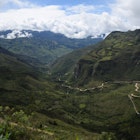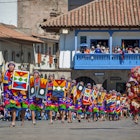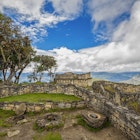
Oct 22, 2025 • 9 min read
It's hard to know where to go in Peru – known for cuisine, culture and biodiversity. Let this list of 13 kickstart a visit to this South American darling.

Oct 22, 2025 • 9 min read
It's hard to know where to go in Peru – known for cuisine, culture and biodiversity. Let this list of 13 kickstart a visit to this South American darling.

Oct 3, 2025 • 5 min read
Whether you're a foodie bound for Lima or an adventurer heading for the Inca Trail, find the perfect time for your Peru vacation here.

Aug 19, 2025 • 6 min read
Peru has long been a destination for backpackers on a budget and now other travelers have caught on – here's how to make your money go further on the road.

Jun 24, 2025 • 10 min read
Often called Machu Picchu's little sister, Choquequirao can only be reached on foot. Lonely Planet editor Melissa Yeager shows you want to expect.

Mar 17, 2025 • 7 min read
Stay fully connected on your next trip to Peru with this guide to local wi-fi networks, roaming charges, eSIMs and data

Jan 15, 2025 • 5 min read
A south-to-north inventory of the best beaches along Peru's unbeatable coastline.

Dec 5, 2024 • 8 min read
Peru's incredible landscape and mix of terrains make it a magnificent hiking destination. Choose your next adventure from our favorite hikes in Peru.

Dec 1, 2024 • 7 min read
Here's what you need to know about culture, etiquette and safety in Peru before you travel to this mesmerizing South American nation.

Jan 30, 2024 • 7 min read
Every adventure-seeking family with a great appetite should have Peru on their "dream destinations" list. Here are the best things to do there with kids.

Dec 14, 2023 • 2 min read
Curious if you need a visa for visiting Peru? Here's all you need to know.

Aug 30, 2023 • 4 min read
There are ways to find lesser-traveled trekking routes to reach magnificent Machu Picchu. Here, our Peru expert recommends a few.

Apr 13, 2021 • 6 min read
Cloud-scraping peaks, lush rainforests, and rivers teeming with life all intertwine in Peru's kaleidoscope of natural wonders. Here are our top picks for this…

Sep 16, 2020 • 6 min read
Get to know the history behind Peru's most famous site: the fascinating Inca citadel of Machu Picchu.

Jul 22, 2020 • 5 min read
From desert to coast, here are some of the most beautiful drives in the Americas to inspire your next road trip.

Apr 30, 2020 • 6 min read
A writer attempts to return to Italy from Peru upon learning that his parents had passed away from COVID-19.

Sep 5, 2019 • 5 min read
The northern city of Chachapoyas is one of Peru’s fastest growing destinations. Here's how to see the ruins and enjoy the town far from the crowds.

Jun 28, 2019 • 5 min read
What if we didn’t have porters to help us achieve our bucket-list trek on the Inca Trail to Machu Picchu? No one to help carry our clothes, tents, gear,…

May 22, 2019 • 3 min read
The solstices hold spiritual and religious meaning in societies around the world, and many of our modern day solstice celebrations have long historical…

Apr 15, 2019 • 6 min read
In the lush valleys of southern Peru, every year between March and April, grapes designated for pisco are harvested, fermented and distilled in order to…

Feb 18, 2019 • 4 min read
Cuzco and the Sacred Valley are no travel secrets – iconic Inca ruins dot the region and world-class hikes wind through its hills, drawing people from all…

Oct 30, 2018 • 5 min read
The Inca Trail is one of the most famous treks in the world, hosting thousands of hikers each year looking to experience the historic path that stretches…

Aug 21, 2018 • 5 min read
Most travelers on a debut tour of Peru struggle to tear themselves away from the evocative ruins of Machu Picchu. But the so-called "lost city of the…